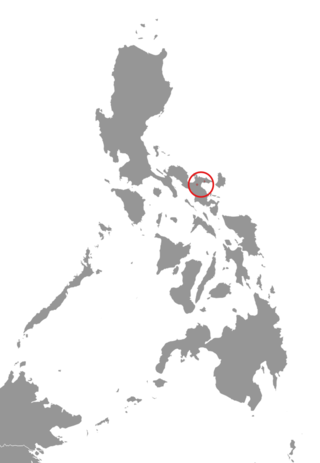Reig's grass mouse is a South American rodent species found in Brazil and Uruguay. It is named after Argentine biologist Osvaldo Reig (1929–1992).

The Mount Isarog shrew-mouse is a species of rodent in the family Muridae found only in the Philippines. Its natural habitats include subtropical or tropical dry forest. It is threatened by habitat loss due to logging operations.

The Isarog striped shrew-rat or Mount Isarog striped rat is a species of rodent in the family Muridae found only in the Philippines.
The Sulawesian shrew rat is a species of rodent in the family Muridae. It is the only species in the genus Melasmothrix. It is found only in central Sulawesi, Indonesia, and is known from the localities of Rano Rano and Mount Nokilalaki.

Handleyomys chapmani, also known as Chapman's oryzomys or Chapman's rice rat, is a species of rodent in the genus Handleyomys of family Cricetidae. It is found only in Mexico. It was previously placed in Oryzomys as Oryzomys chapmani, but has been provisionally transferred to the genus Handleyomys pending the description of a new genus to contain it.
The Giluwe rat is a species of rodent in the family Muridae. It is found only in Papua New Guinea, on Mount Giluwe and the subalpine grasslands of the Kaijende Highlands.
The Timor rat is a species of rodent in the family Muridae found in Indonesian West Timor, where it lives in the teak forests. It is known from a specimen collected near the summit of Mount Mutis.

The Mount Data shrew-rat is a species of rodent in the family Muridae. It is found only in the Philippines.

The Sulawesi montane rat is a species of rodent in the family Muridae. It is found only in central Sulawesi, Indonesia, on Mount Lehio, Mount Kanino, and Mount Nokilalaki.

The spiny long-footed rat, also known as the Mindanao spiny rat, is a species of rodent in the family Muridae.

The long-tailed shrew rat is a species of rodent in the family Muridae. It is found only in Central Sulawesi, Indonesia, where it is known only from Mount Nokilalaki in Sigi Regency.

The Gebe cuscus is a species of marsupial in the family Phalangeridae. It is endemic to the island of Gebe, North Maluku province, Indonesia, where it lives at elevations from sea level to 300 m.

Thomas's fruit-eating bat, sometimes also popularly called Watson's fruit-eating bat, is a species of bat in the family Phyllostomidae. It is found from southern Mexico, through Central America to Colombia. Its South American range is to the west of the Andes. The species name is in honor of H. J. Watson, a plantation owner in western Panama who used to send specimens to the British Natural History Museum, where Oldfield Thomas would often describe them.
Budin's tuco-tuco was formerly considered a species of rodent in the family Ctenomyidae. It is endemic to southeast Jujuy Province in northwest Argentina. Given the extensive human presence in its limited range, it has been suspected to be threatened. The IUCN currently views it as a subspecies of C. frater. It was named after Emilio Budin, an Argentine specimen collector who worked with Oldfield Thomas.
Foch's tuco-tuco is a species of rodent in the family Ctenomyidae. It is endemic to northwestern Argentina, where it is known from southwestern Catamarca Province. The species is named after World War I general Ferdinand Foch.
Roig's tuco-tuco is a species of rodent in the family Ctenomyidae. It is endemic to a small region near the Paraná River in Corrientes Province, northeastern Argentina, where lives on sand dunes, and near rivers. Development is degrading and shrinking this habitat, threatening the rodent's survival. The species is named after Argentine zoologist Virgilio G. Roig. Its karyotype has 2n = 48 and FN = 80.

Tate's fat-tailed mouse opossum is a species of opossum in the family Didelphidae, named after American zoologist George Henry Hamilton Tate. It is found at elevations of 300 to 3,000 m along the coast of central Peru. The species has the northernmost range of any member of its genus. It has white ventral fur and short condylobasal and zygomatic lengths. T. pallidior is very similar.

Tate's woolly mouse opossum is an omnivorous, arboreal South American marsupial of the family Didelphidae, named after American zoologist George Henry Hamilton Tate. It is native to Atlantic coastal forests of Brazil, Paraguay and Argentina. The species lives in both primary and secondary forest, including forest fragments within grassland. Insects are a major component of its diet. It was formerly assigned to the genus Micoureus, which was made a subgenus of Marmosa in 2009. While its conservation status is "least concern", its habitat is shrinking through urbanization and conversion to agriculture over much of its range.

Reig's opossum is a South American opossum species of the family Didelphidae, discovered in 2004. It is named after Argentine biologist Osvaldo Reig (1929–1992). It was initially found in montane forest in Canaima National Park, Venezuela at an elevation of 1300 m in the Sierra de Lema. It is typically found between 1100 m and 2050 m on Mount Ayanganna.
Hylaeamys tatei, also known as Tate's oryzomys or Tate's rice rat, is a South American rodent species of the family Cricetidae. It is known only from the eastern foothills of the Andes in central Ecuador, where it has been found at elevations from 1130 to 1520 m. H. tatei is most closely related to H. yunganus, which occurs throughout Amazonia. The species is found in tropical rainforest and is terrestrial and probably nocturnal. It is named after American zoologist George Henry Hamilton Tate.













